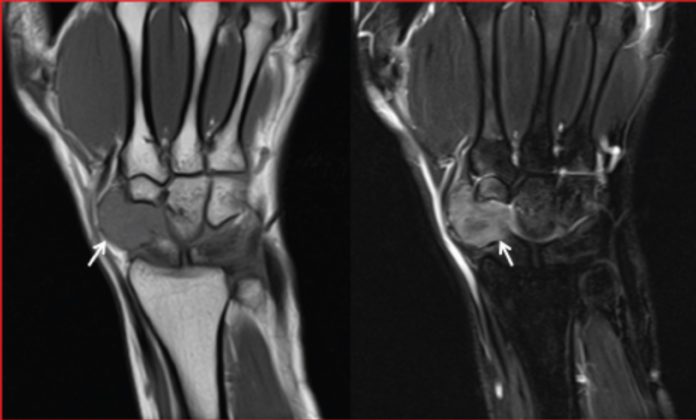A swollen and painful wrist comes out to be a tumour, more precisely, a giant cell tumour of the tendon sheath, in a 21-year-old woman.
Giant cell tumour of the tendon sheath (GCTTS) is a slow-growing, painless, benign, uncommon lesion. It is the second most common tumour of the hand, while ganglion cyst is the most common.
A 21-year-old female presented with complaints of pain and swelling in the left wrist. The physicians admitted her to evaluate further.
Magnetic resonance imaging of the left wrist showed a T1W hypointense, T2W heterogeneously hyperintense mass on the medial aspect of her left wrist. The mass encased the pollicis tendons. Moreover, the lesion showed heterogeneous contrast enhancement.
Her doctors decided to operate on the lesion. Histopathological evaluation revealed that the lesion is indeed a giant cell tumour of the tendon sheath.
GCTTS is made up of multinucleated giant cells, histiocytes, fibrotic material, and hemosiderin deposits. Patients usually present between the third to fourth decade of life, with a slow-growing firm mass that is neither painful nor tender. The mass is located adjacent to the tendon.
Magnetic resonance imaging is the investigation of choice. Moreover, a preoperative MRI is imperative to assess the tumour size, extent, and the involvement or invasion of surrounding structures. The presence of hemosiderin in the lesions appears as small, scattered foci of low signal on T1WIs and T2WIs; however, MRI images can exhibit variable signal intensity.
Management:
The gold standard treatment is complete surgical excision. Usually, localized excision is sufficient. However, despite the complete excision, there is a risk of recurrence. Extensive surgery and radiotherapy are for cases with a recurrent lesion. The factors that increase recurrence risk include incomplete excision and joint involvement. However, more research and studies are required to evaluate the associated risk factors for recurrence.
Moreover, metastases can occur, most commonly to lymph nodes and lungs.
References:
Arslan S, Erdogan H, Durmaz MS, Arslan FZ, Oncu F, et al. (2018) A Rare Case Report: The Giant Cell Tumor of the Tendon Sheath in Wrist. Clin Med Img Lib 4:095. doi.org/10.23937/2474-3682/1510095




